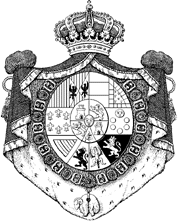 |

In the year 1371 Doña Constanza, daughter
of the deceased (and dethroned) King of Castile, Don Pedro I (The Cruel)
Constanza went to England to become the bride of King Edward III's son,
John of Gaunt, Duke of Lancaster.
Among the young Castilian ladies of aristocratic
birth who accompanied her was Doña Sancha de Ayala, daughter of
Don Diego (or Día-) Gómez de Guzmán (or de Toledo)
and his wife, Doña Inés de Ayala. Diego Gomez de Toledo was
born about 1334, lived in Toledo, New Castile, Spain, and married Inez
Alfonsa de Ayala, bore Sancha about 1355 while living in Toledo, New Castile,
Spain. Inez was born about 1338, lived in Toledo, New Castile, Spain. Inez
was the daughter of Fernan Perez de Ayala and Elvira Alvarez de Zavallos.
About 1373 Doña Sancha married an English
knight, Sir Walter Blount, of the Blounts of Sodington, county Worcester.
On 26 February in the first year of King Richard II's reign (1378), the
Duke of Lancaster, who claimed the thrones of Castile and Leon in right
of his wife, granted to Sir Walter and Sancha (for their good service to
him) an annuity of 100 marks a year; this grant was confirmed "for their
lives in survivorship" by King Richard, April 26, 1399. Records reveal
payments to Sancha at various times; once (2 January 1380) her name was
associated with that of "Phelippe Chaucy", i.e., Philippa Chaucer, wife
of the author of the Canterbury Tales, Geoffrey Chaucer. On this occasion
she was described by the Duke of Lancaster as "our very dear attendant"
(nostre treschere compaigne) "dame Senche Blount".
Sir Walter figured prominently in the affairs
of England during the times of Edward III and Henry IV. He was a close
associate of John of Gaunt, and the latter made him an executor of his
will and left him a small legacy. In 1367, Sir Walter accompanied the Black
Prince and the Duke of Lancaster (John of Gaunt) upon the expedition into
Spain to aid Peter the Cruel, King of Castile, and was at the battle of
Marjara on April 3, 1367 which restored Peter to his throne. Sir Walter
fell at the battle of Shrewsbury, July 21, 1403, wherein, being standard
bearer, he was arrayed in the same style of armour as his royal master
and was slain in single combat by Earl Douglas who believed he was in combat
with the king himself. Sir Walter was slain in the course of the battle
of Shrewsbury, July 21, 1403, and Shakespeare, who drew his facts mainly
from Holinshed's "Chronicles" immortalized him in his Henry IV though
he called him Sir Walter Blunt.
Three years after her husband's death, Dame
Sancha founded a chantry in the Hospital of St. Leonard, Alkmonton, county
Derbyshire. Her son-in-law, John Sutton, (husband of Constance Bount) died
on August 29, 1406. On November 23 following, Dame Sancha was granted commission
of the keeping of all the lands late of John Sutton, tenant in chief, during
the minority of his six-year-old son and heir, John Sutton; her duties
included "finding a competent maintenace for the heir, maintaining the
houses and buildings and supporting the charges." In the same month the
escheator in Worcestershire was ordered "to take of Constance who was the
wife of John Sutton an oath etc. and in the presence of Sancha who was
the wife of Walter Blount knight, to whom the king has committed the ward
thereof, or of her attorneys, to assign the said Constance dower of the
said John's lands."
Dame Sancha Blount made her will (still in
existence) in 1415, and died in 1418. She was buried beside her husband
in the Collegiate Church of St. Mary, The Neward, Leicester. Sancha de
Ayala, Lady Bount, the ancestress of several English settlers in America,
was descended from some of the most illustrious Castilian families. Through
her father she belonged to the House of Guzmán (also called Toledo)
which produced many noble families in Spain and a series of wives and mistresses
for Spanish and Portuguese kings. Her mother, Inés de Ayala (by
whose surname Sancha was known), was sprung from the great House of Ayala
of Toledo, which traced its pedigree in the male line to the House of Haro,
Lords of Biscay. The proof of Sancha's parentage is contained in a family
genealogy begun about 1385 by her maternal uncle, Pedro López de
Ayala, Grand Chancellor of Castile. He stated that Doña Sancha "married
a Knight of England, who was called Sir Walter Blount."
Sancha and Sir Walter had two children, Sir
Thomas Blount and Constance. Sir Thomas was the father of two sons:
(1) Sir Walter Blount, 1st Lord Mountjoy, whose
descendants include Roger Ludlow, first Deputy-Governor of the Colony of
CT and two U.S. Presidents, Benjamin Harrison and William Henry Harrison
and:
(2) Sir Thomas Blount, the ancestor of Anne
Marbury Hutchinson and Katherine Marbury Scott.
Sancha's older brother, Don Pedro Suåarez
was the progenitor of much of Europe's nobility. He married Doña
Juana de Orozco, Lady of Pinto and had Inés de Guzmán or
de Toledo. By her second husband, Don Diego Fernández de Córdoba,
Marshal of Castile, she had a daughter, Doña María Fernández.
Maria, 4th Lady of Casarrubios del Monte; m. Don Fadrique Enriquez and
had Doña Juana Enríquez. Juana, married (1447) as his second
wife, John II, King of Aragon and had Ferdinand II of Aragon, better known
as Ferdinand V, The Catholic, King of Castile, who married the celebrated
Queen Isabella of Castile and had several children including:
Emperor Charles V (Charles I of Spain), ancestor
of the Habsburg and Bourbon Kings of Spain;
Juana "La Loca" ("the crazy"), Queen of Castile,
who married Philip the Handsome, Archduke of Austria;
Ferdinand I, who was progenitor of the Habsburg
Holy Roman Emperors and Emperors of Austria, all of the present European
sovereigns (including Queen Elizabeth II of Great Britain), most of the
dethroned dynasties of Europe, the Calvert family of Maryland, a branch
of the Morris family of Philadelphia, and the Custis-Lee family of the
Arlington Estate in Virginia; and
Catherine of Aragon who married first the Tudor
Prince, Arthur and second, his brother, King Henry VIII of England.

References
-
NGSQ - National Genealogical Society Quarterly, Vol. 51, The Spanish
Ancestry of American Colonists, Milton Rubincam, Washington, D.C.,
Dec 1963, pp. 235 - 236.
-
The English Ancestry of Anne Marbury Hutchinson and Katherine Marbury
Scott, Meredith B. Colket, Jr., The Mager Press, Philadelphia, PA,
1936, p. 46.
-
Oratio Dyer Clark and of his wife Laura Ann King, Together with the
ancestry of Anne (Marbury) Hutchinson, Ancestress of Oratio Dyer Clark,
John Edwin Salisbury, Verified and Enlarged by Martin & Allabdyob,
Asbury Park, NJ, 1917, pp. 79 - 86.
-
TAG - The American Genealogist, Vol. 25, No. 3, The Royal Ancestry
of the Ludlows, Meredith B. Colket, Jr., Demorest, GA, Jan 1939, p.
138.
-
See also McBride

Any comments or queries are welcomed by William
Hester.
|


